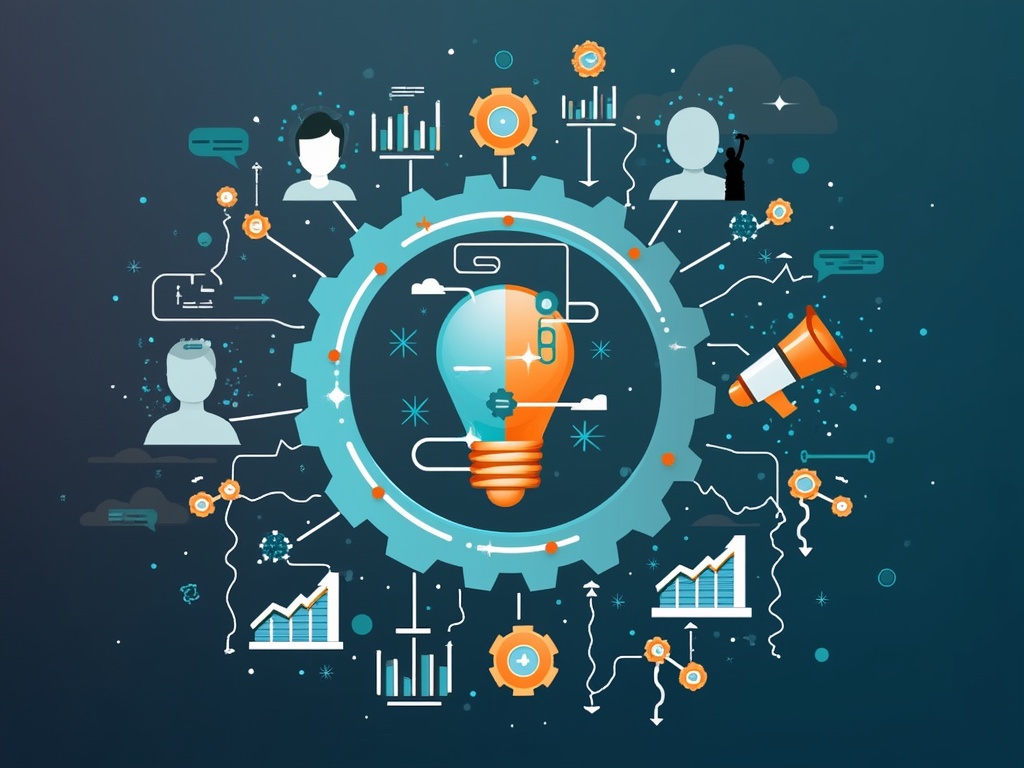Automated success in marketing hinges on leveraging cutting-edge tools and strategies. By implementing intelligent automation systems, businesses can streamline operations, enhance customer engagement, and drive unprecedented growth in today’s competitive landscape.
Key Takeaways:
- Personalization is crucial for effective automated marketing
- Integration of AI and machine learning enhances campaign performance
- Consistent data analysis drives continuous improvement
- Multichannel approach maximizes reach and engagement
- Regular testing and optimization ensure peak efficiency
The Power of Automation in Marketing
In today’s fast-paced digital world, marketing automation has become a game-changer for businesses of all sizes. It’s not just about saving time; it’s about creating smarter, more efficient campaigns that deliver results. By automating repetitive tasks, marketers can focus on strategy and creativity, leading to better outcomes and improved ROI.
Automation allows for precise targeting and personalization at scale. This means you can send the right message to the right person at the right time, increasing the likelihood of conversion. It’s like having a virtual marketing team working 24/7 to nurture leads and keep your brand top-of-mind.

Key Components of Successful Automation
To unlock the secret sauce to automated success, you need to focus on several key components:
1. Data Integration: Your automation is only as good as the data it’s based on. Ensure you’re collecting and integrating data from all relevant sources to create a comprehensive view of your customers.
2. Segmentation: Use your data to create detailed customer segments. This allows for more targeted and relevant communications, improving engagement rates.
3. Workflow Design: Create intuitive workflows that guide customers through their journey with your brand. This includes trigger-based emails, follow-ups, and cross-channel interactions.
4. Content Personalization: Leverage dynamic content to personalize messages based on customer data, behavior, and preferences.
5. Analytics and Reporting: Implement robust tracking and reporting to measure the success of your automated campaigns and identify areas for improvement.
Leveraging AI and Machine Learning
The integration of AI and machine learning takes marketing automation to the next level. These technologies can:
- Predict customer behavior and preferences
- Optimize send times for maximum engagement
- Personalize content in real-time
- Identify trends and patterns in large datasets
By harnessing the power of AI, you can create more intelligent and adaptive campaigns that evolve based on real-time data and insights.
Multichannel Automation Strategies
Effective automation isn’t limited to a single channel. A cohesive multichannel strategy ensures your message reaches customers wherever they are. This includes:
- Email marketing
- Social media automation
- SMS and push notifications
- Chatbots and conversational marketing
- Retargeting ads
By coordinating your efforts across these channels, you create a seamless customer experience that reinforces your brand message and drives engagement.
Continuous Optimization and Testing
The secret to long-term automated success lies in constant refinement and testing. Regular A/B testing of your automated campaigns can help you identify what resonates best with your audience. This includes testing:
- Subject lines and email content
- Call-to-action buttons and placement
- Landing page designs
- Timing and frequency of communications
By analyzing the results and making data-driven decisions, you can continuously improve the performance of your automated marketing efforts.
Overcoming Common Automation Challenges
While automation offers numerous benefits, it’s not without its challenges. Some common hurdles include:
1. Data Quality: Ensure your data is clean, up-to-date, and properly integrated to avoid sending irrelevant or incorrect messages.
2. Over-Automation: Don’t lose the human touch. Find the right balance between automated and personalized interactions.
3. Compliance: Stay up-to-date with data protection regulations like GDPR and CCPA to maintain trust and avoid legal issues.
4. Technical Skills: Invest in training or partner with experts to fully leverage your automation tools.
Future-Proofing Your Automation Strategy
As technology evolves, so should your automation strategy. Stay ahead of the curve by:
- Keeping up with emerging technologies and trends
- Regularly auditing and updating your automation workflows
- Investing in scalable solutions that can grow with your business
- Fostering a culture of innovation and continuous learning
By embracing these principles, you’ll be well-positioned to optimize your business processes and maintain a competitive edge in the ever-evolving world of digital marketing.
Conclusion
Unlocking the secret sauce to automated success isn’t about finding a single magic solution. It’s about combining the right tools, strategies, and mindset to create a powerful, adaptive marketing machine. By focusing on data-driven personalization, leveraging AI and machine learning, adopting a multichannel approach, and committing to continuous optimization, you can create automated campaigns that not only save time but drive real, measurable results for your business.
Remember, the key to success lies in striking the right balance between automation and the human touch. Use technology to enhance your marketing efforts, but never lose sight of the personal connections that truly drive customer loyalty and business growth.
Sources:
Frequently Asked Questions
Q: What is marketing automation, and how does it benefit my business?
Marketing automation is the process of using technology or software to automate repetitive marketing tasks across multiple channels. This helps businesses streamline their marketing efforts, nurture leads more effectively, and enhance customer engagement. By automating tasks, marketers can focus on strategy and creativity, leading to better outcomes and improved ROI[4].
Q: How does AI and machine learning enhance marketing automation?
AI and machine learning integrate with marketing automation to predict customer behavior and preferences, optimize send times for maximum engagement, personalize content in real-time, and identify trends and patterns in large datasets. This creates more intelligent and adaptive campaigns that evolve based on real-time data and insights[5].
Q: What are the key components of a successful automated marketing strategy?
Successful automated marketing strategies include data integration, customer segmentation, workflow design, content personalization, and robust analytics and reporting. These components ensure that automated campaigns are targeted, relevant, and continuously improved[2][5].
Q: How can I ensure my automated campaigns are personalized and effective?
To ensure personalization, use dynamic content based on customer data, behavior, and preferences. Implement AI-driven recommendation engines to suggest products or content tailored to individual customers. Regularly test and optimize your campaigns to identify what resonates best with your audience[2][5].
Q: What are some common challenges in implementing automated marketing, and how can I overcome them?
Common challenges include data quality issues, over-automation, compliance with data protection regulations, and the need for technical skills. To overcome these, ensure your data is clean and integrated, maintain a balance between automated and personalized interactions, stay compliant with regulations, and invest in training or partner with experts to fully leverage your automation tools[5].
People Also Ask
How Can I Implement AI in My Marketing Automation Strategy?
Implementing AI in your marketing automation strategy can significantly enhance your campaign performance and customer engagement. Here are some key steps to consider:
- Leverage Predictive Analytics: Use AI-powered predictive analytics to forecast customer behavior, preferences, and trends. This allows you to anticipate and prepare for future marketing needs, optimizing your campaigns for better results[2][5].
- Personalize Content: AI enables real-time personalization of content based on customer data, behavior, and preferences. This can be achieved through AI-driven recommendation engines and dynamic content personalization, increasing engagement and conversion rates[2][5].
- Automate Repetitive Tasks: AI can automate repetitive tasks such as email marketing, social media engagement, and lead scoring, freeing up time for more strategic and creative activities[2][5].
What Are the Key Components of a Successful Marketing Automation Strategy?
A successful marketing automation strategy involves several critical components:
- Data Integration: Ensure you are collecting and integrating data from all relevant sources to create a comprehensive view of your customers. Clean and accurate data is essential for effective automation[4].
- Segmentation: Use your data to create detailed customer segments, allowing for more targeted and relevant communications. This improves engagement rates and the overall effectiveness of your campaigns[4].
- Workflow Design: Create intuitive workflows that guide customers through their journey with your brand. This includes trigger-based emails, follow-ups, and cross-channel interactions[4].
- Analytics and Reporting: Implement robust tracking and reporting to measure the success of your automated campaigns and identify areas for improvement. Regular analysis and A/B testing are crucial for continuous optimization[1][4].
How Can I Balance Automation with the Human Touch in Marketing?
Balancing automation with the human touch is crucial for maintaining customer loyalty and driving business growth. Here are some tips:
- Avoid Over-Automation: Ensure that you do not lose the personal touch in your interactions. Find a balance between automated and personalized messages to keep your communications relevant and engaging[4].
- Use AI to Enhance Human Interactions: AI can help in personalizing messages and interactions, but it should not replace human touch entirely. Use AI to support and enhance your human interactions rather than replace them[2][5].
- Focus on Customer Experience: Always prioritize the customer experience. Use automation to streamline processes but ensure that every interaction, whether automated or manual, adds value and feels personal to the customer[1][4].
What Are the Benefits of a Multichannel Approach in Marketing Automation?
A multichannel approach in marketing automation offers several benefits:
- Maximize Reach and Engagement: By using multiple channels such as email marketing, social media automation, SMS and push notifications, and retargeting ads, you can reach your customers wherever they are, maximizing engagement and reach[4].
- Seamless Customer Experience: A cohesive multichannel strategy ensures a seamless customer experience across all touchpoints, reinforcing your brand message and driving engagement[4].
- Increased ROI: Coordinating efforts across multiple channels can lead to higher ROI as it allows you to target customers more effectively and consistently[4].
How Can I Optimize My Marketing Automation Campaigns for Better Results?
Optimizing your marketing automation campaigns involves continuous refinement and testing. Here are some steps to follow:
- Regular A/B Testing: Conduct regular A/B testing of your automated campaigns to identify what resonates best with your audience. Test elements such as subject lines, email content, call-to-action buttons, and timing of communications[1][4].
- Data-Driven Decisions: Analyze the results of your tests and make data-driven decisions to continuously improve the performance of your automated marketing efforts[1][4].
- Monitor Key Metrics: Track key performance indicators (KPIs) such as conversion rates, customer lifetime value, and cost per lead to measure the success of your campaigns and identify areas for improvement[4].

